Abstract
In agriculture, balancing water use and retention is an issue dealt with in most regions and for many crops. In this study, we suggest agricultural water equilibrium (AWE) as a new concept that can facilitate a spatially explicit management of agricultural water. This concept is based on the principle of supply and demand of agricultural water, where the virtual water content of crops (VWC) can be defined as the demand, and cropland water budget (CWB) as the supply. For assessing the AWE of the Korean Peninsula, we quantified the CWB based on the hydrological cycle and the VWC of rice, a key crop in the Peninsula. Five factors, namely crop yield, growing season evapotranspiration, annual evapotranspiration, runoff, and annual precipitation, were used to assess the AWE, of which the first four were estimated using the spatially explicit large-scale crop model, Geographical Information System (GIS)-based Environmental Policy Integrated Climate (GEPIC). The CWB and VWC were calculated for a period of three decades, and the AWE was computed by deducting the VWC from the CWB. Our results show a latitudinal difference across the Korean Peninsula. On analyzing the AWE of the major river basins, we found most basins in North Korea showed very low values inferring unsustainable overconsumption of water. The latitudinal difference in AWE is a reflectance of the latitudinal changes in the VWC and CWB. This can be explained by decoupling the demand and supply of agricultural water. Although the AWE values presented in this study were not absolute, the values were sufficient to explain the latitudinal change, and the demand and supply of agricultural water, and establish the usefulness of the indicator.
1. Introduction
Striking a balance between water retention and water use is a challenge faced by most industries that use water, and is one of the most pressing issues in agriculture [1,2,3]. As climatic and socio-economic changes progress, the decoupling between water retention and usage widens [4,5]. Earlier studies have demonstrated both scientifically and socio-scientifically, how climate change causes shortages of water and how consumption of water increases owing to increased consumption and production of goods [6,7,8].
Climate change does not refer to changes in temperature alone, but also to changes in all other climatic factors. This includes hydrological changes, which could result in droughts or floods, and such extreme natural events could be disastrous, affecting the growth of plants, and causing price fluctuations of agricultural products [9,10,11]. From the perspectives of production and consumption, the industry that is most sensitive to water retention and water consumption rates is agriculture [12,13]. The land water budget, determined from the hydrological cycle, has exerted the most extensive influence on the agricultural production regardless of the emergence of diverse irrigation methods and new technologies [4,14,15]. To explain the volume of water retained in the soil and available for agriculture, it is possible to utilize concepts such as water balance, water budget, and water resource among others [16,17,18]. These values have been estimated annually by using various variables in appropriate models.
The volume of water consumed is determined by the rate of evapotranspiration. Usually, the actual rate of evapotranspiration that occurs during the growing phase of a crop is defined as the water consumption level for that crop [19,20,21]. Recently, a virtual water concept has been applied to crop production that presents the volume of water used per unit crop yield [22].
To specify the water retention and the water consumption in the agricultural sector, Liu et al. [23] estimated the consumptive water use (CWU) for various crops across the world under potential climate change using the Geographical Information System (GIS)-based Environmental Policy Integrated Climate (GEPIC) model. Zhao et al. [22] calculated the virtual water contents of crops in China using the same model. Furthermore, Fader et al. [4] presented renewable water resources for each country based on the LPJmL (Lund–Potsdam–Jena managed Land) model, and Shen et al. [16] estimated the cropland water balance based on field measurements. Likewise, many studies have effectively used crop models to estimate water retention and water consumption in agriculture to investigate their relationship.
Such crop models have predominantly been utilized across various agricultural systems for estimating crop yield besides externalities such as hydrological cycle, soil organic matter turnover, and soil erosion of agricultural lands [4,24,25,26]. Within the wide range of crop models developed across the world, each has its unique characteristics [27]. For example, the EPIC model is effective for studying supply and demand of agricultural water, as it estimates a comprehensive number of variables related to crop productivity, the hydrological cycle, and soil erosion [28,29]. Studies on crop productivity and water use that utilize the EPIC model have been conducted widely compared to other models [22,23,30].
Although the balance between the demand and supply is a fundamental part of economics, there have been very few studies on the demand and supply of water in agriculture [31,32]. In particular, there has been no prior research to determine the precise demand and supply of water based on spatial data. Recently, there have been many cases reporting the loss of the water balance owing to excessive usage of water in the process of food production across the world. In addition, a decoupling phenomenon has also occurred, wherein the food production has been increasing, but the volume of water available for agriculture has been decreasing [4,33]. To investigate such phenomenon, crop models can be used effectively to estimate the water budget in an agricultural land and the volume of water consumed by crops in that land, and thus check the supply and demand of water [18,22]. Although not explored in earlier studies, if it is possible to calculate the volume of supply and that of demand, then even the equilibrium state of agricultural water can be assessed on the basis of the difference of the two values.
In this study, we address this and assess the spatially explicit agricultural water equilibrium (AWE) of the Korean Peninsula by using the widely applied crop model GEPIC, which has prior been set up and evaluated for the study region [34]. To this end, the volume of supply and demand of agricultural water were quantified by estimating the cropland water budget (CWB) based on the natural hydrological cycle and the virtual water contents (VWC) of rice, a key crop in the Korean Peninsula and representative high-water-demand crop. Variables required for this calculation were estimated using the GEPIC model, which was also used to check the time-series change and annual average level in the Korean Peninsula during the past 30 years. Using the results of our assessments, we tested for latitudinal difference in the agricultural water equilibrium for the Korean Peninsula.
2. Data and Method
2.1. The Concept of Assessing Agricultural Water Equilibrium
The concept of agricultural water equilibrium is used to explain the balance between non-anthropogenic water budget of agricultural land and the volume of water consumed by crop. It is an assessment criterion of sustainable agricultural water consumption, based on the principle of supply and demand. Traditionally, many attempts have been made to assessment of water balance in agriculture [8,14,17,31,32]. However, in most existing studies, the supply-oriented assessment [16,20,35,36,37] and the demand-oriented assessment [19,21,22,23] were suggested independently, and the spatially explicit assessment was not easy to find. Assessing agricultural water demand and supply in spatially explicit conditions is a major advantage of the AWE concept. The overall process of calculating these AWEs is shown in Figure 1.

Figure 1.
The concept and flow of this study. GIS, Geographic Information System; EPIC, Environmental Policy Integrated Climate model; GET, growing season evapotranspiration; AET, annual actual evapotranspiration; VWC, virtual water content; CWB, cropland water budget.
To calculate the water budget of agricultural land, the cropland water budget (CWB) was estimated based on annual precipitation, annual actual evapotranspiration (AET), and runoff (Equation (1)). Annual precipitation is defined as the total volume of water supplied to the agricultural land every year, the AET is the portion of this put into the atmosphere from the soil and the plants, while runoff is that portion not used in agriculture and is drained off [35,36,37]. Hence, by using these three factors, it is possible to quantify and understand the water budget of agricultural land in non-anthropogenic condition.
To estimate the volume of water consumed by crop, the concept of virtual water content (VWC) was utilized. VWC is defined as the ratio between CWU (consumptive water use) and crop production volume, whereas CWU refers to the volume of actual evapotranspiration during the growing season of each crop (growing season evapotranspiration, GET) (Equation (2)) [23,38]. VWC is inversely related to the crop water productivity and hence can be used as an indicator of the same [22].
In agricultural land, the available volume of water is CWB, and that used in crop production is VWC. Thus, by subtracting VWC from CWB, we can get AWE (Equation (3)). The CWB (mm) and VWC (mm t−1) are different from each other in unit, but assume that they produce 1 ton of crop and calculate after removing ton from VWC. The higher the AWE value, the better is the water balance.
The AWE can effectively describe changes in water balance resulting from agricultural activities and climatic changes, which this study aims to verify. However, there are some duplicated volumes of evapotranspiration used in calculating the CWB and VWC. Though using both the AET and GET values could duplicate the total amount of annual evapotranspiration, as they differ conceptually, therefore, AWE is assessed in relative terms rather than in absolute terms. In other words, AWE should be used as a concept of indicator rather than total amount. In addition, as the presented VWC is the quantity of water required to produce a ton of the relevant crop, the water equilibrium is assessed by spatial difference based on the amount of water used when 1 ton of representative crop is produced.
Of the five factors used to estimate AWE, except annual precipitation, the remaining variables (crop yield, GET, AET, and runoff) were estimated by using the GEPIC model.
2.2. GEPIC Modeling of Each Variable
The EPIC (Erosion Productivity Impact Calculator) model was developed by the USDA for figuring out soil loss and productivity relationship, and was continuously refined and developed by supplementing the additional modules to improve the simulation of plant growth [39,40]. The model was renamed to Environmental Policy Integrated Climate model, combining environmental assessment of pesticides and water quality [41]. The EPIC is mainly composed of plant growth and crop yield, inter-plant competition, soil and hydrology, nutrient and carbon cycling, soil moisture and temperature, soil erosion, tillage, and plant environment control [42].
We used the modified GEPIC model, which integrates of a Geographical Information System (GIS) into the EPIC version 0509 to improve simulation to be spatially explicit [43,44]. By integrating the GIS and the EPIC model through data transition, the GEPIC can use all the functions of the EPIC model [44]. GEPIC has been extensively used for the last decade to simulate crop productivity, water use of crop, and agro-environment over wide areas [22,34,43,45].
In this study, we estimated four variables (crop yield, GET, AET, and runoff) using the GEPIC model for each grid cell of size 1 sq. km. Rice was used as a model crop since it is the key food crop in the Korean Peninsula and has a high water demand [22,46,47]. The key crop parameters were set following Xiong et al. [47], and Tan and Shibasaki’s [48] calibration result for rice using the EPIC model. The biomass–energy ratio was set to 30 kg MJ−1, optimum temperature to 25 °C, base temperature to 10 °C, harvest index to 0.60 mg mg−1, and potential heat unit (PHU) range to 1300–1800 °C, depending on the specific grid cell climate.
The calculation of evapotranspiration in the GEPIC model can be using the Penman–Monteith method, the Priestly–Taylor method, the Hargreaves method, or the Baier–Robertson method [30,49]. In this study, the Penman–Monteith method, the more widely used precision estimation method, was used to estimate GET and AET. In the case of runoff, the GEPIC model follows the GLEAMS (Groundwater Loading Effects of Agricultural Management System) model equation, which is the standardized equation used to estimate the volume of runoff in agriculture [50,51].
2.3. Study Region
The study area was the Korean Peninsula, which includes the entirety of South and North Korea located between latitudes of 33.23° N and 43.01° N and longitudes of 124.14° E and 130.93° E (Figure 2). The spatial resolution was set at approximately 1 km for the raster datasets that were used as input data and all results are reported at the same spatial scale.
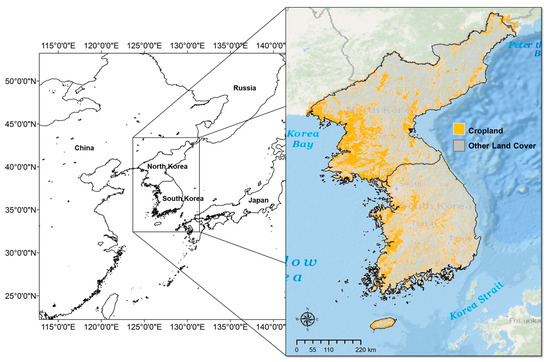
Figure 2.
Study area including South and North Korea.
In South Korea, the area under agriculture is approximately two million ha, accounting for 20% of the total land area. Of this, over 48% are presently under rice cultivation. In North Korea, the land use patterns are similar to that in South Korea, with over three million hectares, accounting for 25% of the total land area, under agriculture. Rice fields account for 49% of this.
The topographic profile of Korean Peninsula is high mountains to the north and east, and lower plains towards the south and west. The average annual temperature is approximately 10–16 °C with about 1200 mm of annual rainfall [49].
2.4. Input Data
The data that was used in the GEPIC model included daily meteorological data (minimum and maximum temperature, solar radiation, precipitation, relative humidity, and wind speed), monthly statistical weather data, PHU, soil data, land cover data, fertilizer amount, irrigation level, elevation, slopes, planting dates by crop phenology, and crop parameters.
Daily meteorological data were acquired from online climate data portal system of KMA (Korean Meteorological Administration) using 102 weather stations for the period 1984–2013. For points for which there were no records, the parameters were determined using the inverse distance weighted (IDW) and Kriging interpolation methodologies for 1 km spatial resolution. The IDW method was used for precipitation, wind speed, solar radiation, and relative humidity, and the Kriging method was applied to the interpolating minimum and maximum temperature [52,53]. The monthly statistical weather data were disaggregated to daily information with a MODAWEC weather converter [54].
GEPIC required PHUs estimation using accumulated by a crop phenology from the time of sowing to maturity, and it used a detailed regional identification of crop management practices. We used the PHU calculator developed by Texas Blackland Research and Extension Center for PHUs of Korean Peninsula [55].
Soil parameters (sand (%), OC (%), silt (%), pH, bulk density (t m−3), electrical conductivity (mS cm−1), cation exchange capacity (cmol kg−1), and layer depth (m)) were acquired from the ISRIC-WISE database and geographical connected to the Digital Soil Map of the World [56,57].
Land cover information was taken from an EGIS (Environmental Geographic Information Service) system developed by Ministry of Environment in South Korea using Landsat 7 satellite images. Terrain information was derived from the USGS’s Global Multi-Resolution Terrain Elevation Data 2010. Slope data was constructed from the elevation dataset using the software ArcGIS 10.2. These datasets were then resampled to 1 km for unification of spatial resolution.
Data on fertilizer application rates were obtained from FertiStat database, the South Korea amount was 255 kg ha−1 (N) and 87 kg ha−1 (P), North Korea was 129 kg ha−1 (N) and 14 kg ha−1 (P) [58]. Data on irrigation level was obtained from the IFPRI-SPAM database [59]. The planting and harvest dates of rice were calculated for each grid using crop phenology.
2.5. Evaluation of Model Performance
Before assessing the agricultural water equilibrium, the four variables estimated using the GEPIC model were verified to evaluate the performance of the model. However, GET was estimated by same algorithms of AET, and observational data on river basins were used in the case of runoff, due to which there were some limitations in verifying the grid-based estimates in cropland. Thus, in this study, we verified the estimates made based on the crop yield, which were then used to calculate the VWC and the AET, which were further used to calculate the CWB.
The estimates were calculated for the period between 1984 and 2013, and temporal points at which detailed data were available were used for verifying each variable. In the case of crop yield, statistical data of North Korea were available only at the national level, and hence the estimates were verified in South Korea. The validation period was set between 1996 and 2013, for which period statistical survey data of rice production were available from the local government. In case of AET, for which large-scale observations are not available, verification was done using evapotranspiration data estimates based on remote sensing for the period between 2000 and 2013, for which MODIS (Moderate Resolution Imaging Spectroradiometer) images were available. The rice production data were referred from KOSIS (Korea Statistical Information System), and for water budget, MOD16 Product from NTSG (Numerical Terradynamic Simulation Group) based on MODIS satellite images.
Three statistical indicators were used to validate the model performance: (i) Root Mean Square Error (RMSE), (ii) Nash–Sutcliffe Efficiency Coefficient (NSEC), and (iii) Relative Error (RE) [60,61]. These statistical measures have been described in detail in literature [34,42].
3. Result and Discussion
3.1. Evaluation of Model Performance
3.1.1. Evaluation of Crop Yield
First, during the validation period for rice production, the statistical data showed annual average values of 4.27–5.19 t ha−1, while estimates were 4.47–5.16 t ha−1, which showed a quantitatively similar trend. The RMSE values were <1, indicating only small differences between the statistical data and estimates. The NSEC values were generally good and ranged between −1.61 and 0, though in Year 3, it was less than −1, which showed that there was discrepancy. The results of RE modeling showed errors less than 10% in every year, and less than 5% in most years, implying that the modeling results were at low level of error (Table 1). Lim et al. [34] have made similar evaluations in Korea, and Balkovič et al. [42] in Europe.

Table 1.
Evaluation of model performance in estimating rice yield.
3.1.2. Evaluation of AET
MODIS AET values were between 745 mm and 855 mm during the validation period, and the AET values estimated by using the GEPIC model were 628–702 mm (Table 2). Thus, it appears that the GEPIC model tended to underestimate compared to the MODIS product. Standard deviations also showed differences of two times the average, and deviation of the MODIS in the areas of focus was twice larger than that of the GEPIC. It was further confirmed using statistical verification that the difference of the two values was larger than that of the rice yield, though the difference could be recognized as having sufficient similarity. Although the RMSE values were over 80, the similarity between the values was comparable to that of the rice yield. The NSEC values were higher than those of rice yield, but their values also have sufficient significance. The RE showed that the level of error was 10–17%, which implied that the MODIS AET was overestimated (Table 2).

Table 2.
Evaluation of model performance in estimating AET.
Since both AET values are estimates, their comparison can here only serve for an approximation of model performance. The small errors and good performance indicators allowed us to conclude that the GEPIC estimates are adequate for agricultural water consumption studies in the region.
3.2. Estimation of the Virtual Water Content and Water Balance
3.2.1. Estimates of Water Balance-Related Variables
To calculate AWE, CWB, and VWC, four variables were estimated annually at a high spatial resolution for a period of 30 years (from 1984 to 2013). The average data across the 30-year period showed that, spatially, in case of the crop yield, the productivity was higher in South Korea, which tended to become lower towards the northeast (Figure 3). This is an effect of climatic factors, which corresponds to the actual agricultural productivity [62]. The GET results showed that the values in the coastal plains were relatively lower, and appeared higher towards interior of the region. Since such higher GET values indicate large water consumption by crops, it is a negative factor in terms of the water balance (Figure 3). In the southwest part of the Korean Peninsula where crop productivity is high and water consumption low, it was expected that the volume of water consumed for crop production would be smaller.
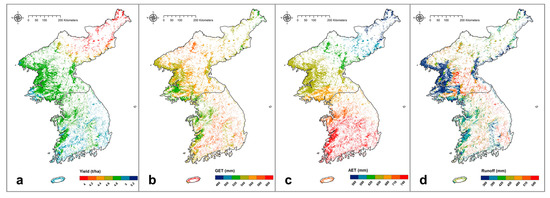
Figure 3.
Three decades average value of each estimated variables ((a) rice yield; (b) GET; (c) AET; (d) runoff).
The AET results explained the differences in latitude and topography. They showed a similar pattern as that of temperature distribution (Figure 3). It appeared that the higher the latitude, the lower the AET became, which showed that the volume of water put into the atmosphere was reduced. The runoff estimates were influenced considerably by topographical factors. Agricultural lands located in the inland mountainous areas showed higher runoff, while those in coastal plains tended to have smaller runoff. The runoff values showed a large discrepancy especially in the agricultural lands of North Korea (Figure 3). Results indicate that the lower the latitude, or the closer the pixel is to the inland mountainous areas, the higher the loss of water in agricultural lands becomes.
3.2.2. Virtual Water Content in the Past Three Decades
The average VWC of rice in the Korean Peninsula during the 30-year period, calculated by using the rice yield and the GET data, was 118.8 mm/t. The average VWC was 124.9 mm/t in the 1980s, and reduced to 116.6 mm/t in the 1990s. This further reduced, although slightly, to 114.9 mm/t in the 2000s. It was confirmed that the volume of water required for rice production has reduced slightly over time, thus changing the water balance in a positive direction when assuming a constant extent of rice harvest area. The cause of such decrease in VWC was explained by the slight increase of crop yield owing to changes in temperature and solar radiation, rather than by changes in GET [47].
In the 1980s, the VWC in South Korea was 113.2 mm/t, while North Korea was 132.1 mm/t for the same period, which showed that the quantity of water consumed for crop production in the two regions differed considerably. However, this difference became smaller over time. In the 1990s, in South Korea the VWC was 115.9 mm/t, and in North Korea, 116.9 mm/t; though in the 2000s, South Korea recorded a VWC of 113.6 mm/t, and North Korea 115.7 mm/t (Figure 4). It was confirmed that the above changes over time were caused by the improved potential crop productivity in North Korea following the rise in temperature. However, the actual food productivity of North Korea was not seen to improve in the same period, largely owing to social influence [63,64].
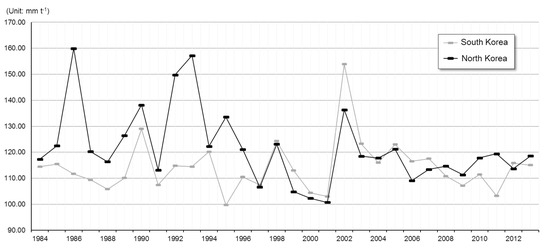
Figure 4.
Comparison of the virtual water content for South and North Korea over a 30-year period.
Spatially, although there were no big differences in most regions during the 30-year period, it was expected that the northeast region of the Korean Peninsula would show a high level of VWC. This is because crops in this region need longer growth periods owing to the lower temperatures, which in turn decreases the productivity. However, it appears that the productivity in the northeast region improved significantly, and the change in the region caused the decrease of VWC in North Korea (Figure 5).
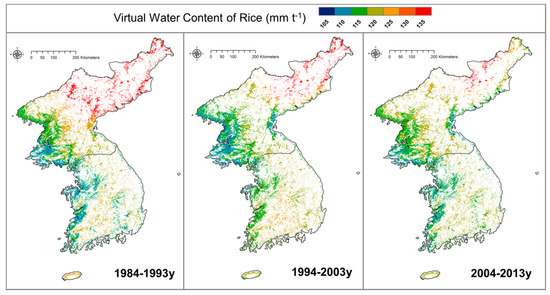
Figure 5.
Spatial distribution and change of virtual water content in the Korean Peninsula over three decades.
3.2.3. Cropland Water Budget in the Past Three Decades
The average CWB in the Korean Peninsula in the 30-year period, estimated based on precipitation, AET, and runoff, was 6.9 mm. It was 17.8 mm in the 1980s, −47.8 mm in the 1990s, and 50.9 mm in the 2000s, indicating very large deviations over time. It was confirmed that the cause of this phenomenon was the variability of precipitation. While the AET changed progressively over time, and the runoff showed spatial differences, the precipitation showed large variability in both space and time, and hence, can be considered the major factor causing changes to the water budget.
When comparing South Korea and North Korea, it was seen that, in the 1980s, South Korea had larger CWB with 80.4 mm compared to −20.8 mm in North Korea. While this difference became larger in the 1990s with 53.7 mm in South Korea and −110.3 mm in North Korea, in the 2000s, the gap became narrower with a CWB of 88.1 mm in South Korea and 27.9 mm in North Korea. One of the reasons was the higher precipitation across the Korean Peninsula in the 2000s. The 1990s witnessed lower precipitations than the other years, and severe droughts were reported in North Korea [26]. Since the precipitation is the only input factor in the water budget, the Korean Peninsula shows large annual variability in precipitation and large fluctuations in the water budget (Figure 6).
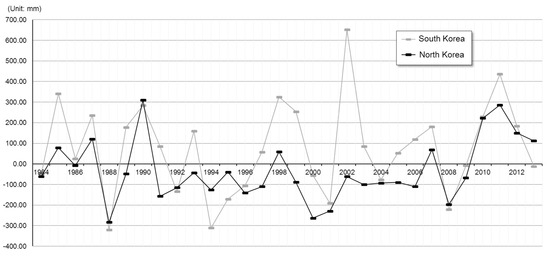
Figure 6.
Comparison of the cropland water budget for South and North Korea over a 30-year period.
Spatially, CWB appeared higher in the southern regions, which receive more precipitation traditionally and the coastal regions show smaller runoff. On the other hand, central mountainous areas and northeast regions showed lower CWB (Figure 7).
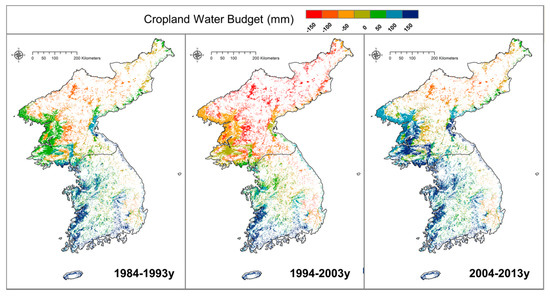
Figure 7.
Spatial distribution and change of the cropland water budget in the Korean Peninsula over three decades.
When comparing with the VWC, the values showed large deviations both temporally and spatially. From the perspective of the theory of demand and supply, it was understood that the demand was relatively stable, but the supply showed larger variability.
3.3. Assessing the Agricultural Water Equilibrium in the Past Three Decades
AWE over the 30-year period was computed by deducting VWC, which indicates the water demand in croplands, from CWB, which indicates the water supply (Figure 8). In the 1980s, the average AWE value in the Korean Peninsula was −107.2 mm, which reduced to −164.4 mm in the 1990s, and then considerably improved to −64.0 mm in the 2000s. The average AWE in the 30-year period was −111.8 mm. The major factor influencing such differences over time was precipitation. Higher amounts of precipitation across the Korean Peninsula in the 2000s resulted in the higher AWE values.
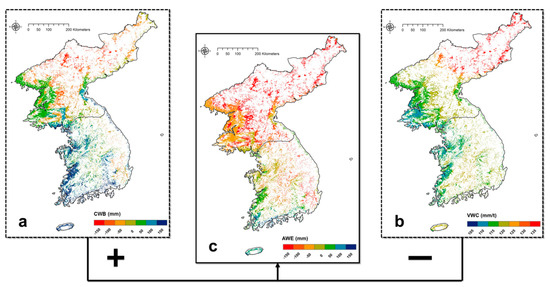
Figure 8.
Spatial integration of (a) the cropland water budget (CWB) and (b) virtual water content (VWC) for assessing (c) the agricultural water equilibrium (AWE).
When comparing South Korea and North Korea, it was confirmed that the AWE for South Korea has been higher at all times. In the 1980s, AWE for South Korea and North Korea were −32.7 mm and −152.8 mm, respectively; while in the 1990s, South Korea was 62.1 mm and North Korea was −227.2 mm. In the 2000s, South Korea was −25.5 mm, and North Korea was −87.7 mm. Over the entire three decades, the AWE for South Korea was −40.2 mm, and for North Korea was −155.9 mm (Figure 9).

Figure 9.
Comparison of the Agricultural Water Equilibrium (AWE) between South and North Korea over three decades.
At the national levels, it could be confirmed from Figure 9 that North Korea had considerably lower AWE. In the 1990s, the AWE was generally very low except for the southern part of the Korean Peninsula. In the same period, North Korea suffered severe food shortage called the ‘March of Ordeal’. In the 2000s, western and eastern plains of North Korea showed AWE values similar to those of South Korea, so it was expected that the use of water in agriculture were much improved than before (Figure 10).
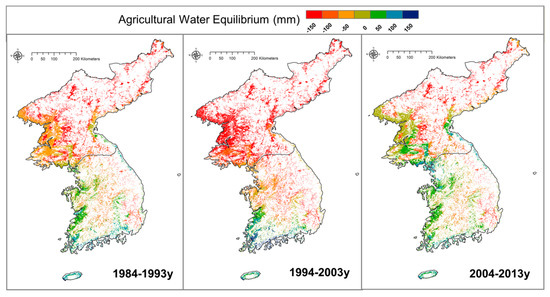
Figure 10.
Spatial distribution and change of Agricultural Water Equilibrium over three decades.
3.4. Agricultural Water Equilibrium at the Main River Basin Level
When sorting AWE data by the major river basins of the Korean Peninsula, it was confirmed that the values showed considerable discrepancies by latitude. In particular, most river basins in North Korea showed very low levels. The Yalu river basin, the longest and broadest in the Korean Peninsula, showed −275 mm on average, which meant that it was in the most non-equilibrium state. In river basins of the Youngsan River and the Sumjin River in South Korea, most areas showed positive AWE values, so it was confirmed that these river basins are those that have the most reserves of water, sufficient for agricultural use (Figure 11).
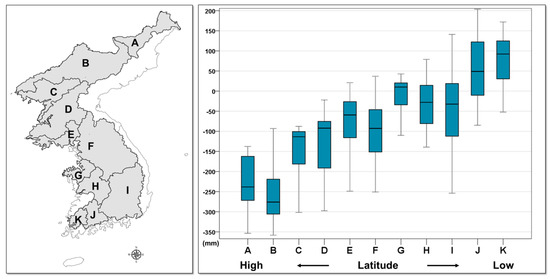
Figure 11.
Assessing the Agricultural Water Equilibrium on the main river basins level (A: Tumen; B: Yalu; C: Cheongcheon; D: Daedong; E: Yeseong; F: Han; G: Sapgyo; H: Geum; I: Nakgong; J: Sumjin; K: Youngsan).
Since the 11 major river basins presented in Figure 11 show the agricultural centers, which are the representative regions producing food crop in the Korean Peninsula, the assessment of AWE in these regions could be connected to the actual characteristics of agricultural environment, which are more meaningful than the assessment based on administrative divisions.
3.5. Virtual Water Content, Cropland Water Budget, and Agricultural Water Equilibrium Along the Latitude
The AWE value showed a large difference with latitude. As shown in Figure 12, the difference across latitudes was larger than across longitude, and this is reflected in the difference in AWE between South Korea and North Korea.
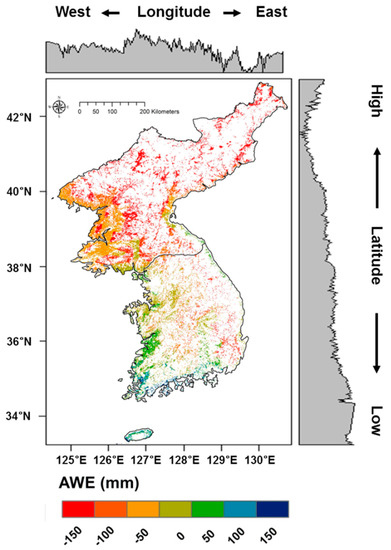
Figure 12.
Aggregated Agricultural Water Equilibrium along the longitude and latitude.
Furthermore, this difference in AWE across latitudes is the result of the latitudinal differences in VWC and CWB. Spatially, there is relatively small difference in water consumption of crop (Figure 13a). Since in higher latitudes, the crop productivity is reduced and the growth duration becomes longer, the water consumption tends to increase. On the other hand, water supply (retention) in agricultural land tends to drop considerably from low latitudes to high latitudes. Such significant differences with latitude tend to make a larger difference to the AWE values, and the decoupling of the demand and supply of agricultural water can explain this.
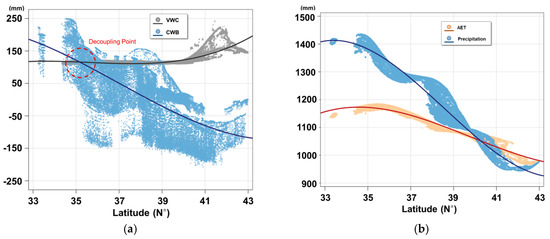
Figure 13.
Latitudinal comparison of each indicator. (a) Virtual Water Content—Cropland Water Budget; (b) AET—Precipitation.
A more fundamental cause is that, at higher latitudes, both precipitation and AET drop concurrently, though there is a difference in the rate of decrease (Figure 13b). Thus, at a certain point of time, there are areas in which the precipitation exceeds the AET, which supply sufficient water to land [36,37]. However, regions above 40 °N in latitude in the Korean Peninsula—that is, North Korea—the relationship is reversed, so that negative conditions for the fundamental water balance appear. Such climatic characteristics may differ by region, but in East Asia, which experiences a temperate monsoon climate, there is a good possibility of seeing a similar pattern [65].
4. Conclusions
AWE values over the 30 years were computed by deducting VWC, which showed demands in croplands, from the CWB, representing the water supply. The GEPIC model was used for successfully estimating on key variables (rice yield, GET, AET, and runoff) in the whole Korean Peninsula. The AWE results showed a vertical difference between South and North Korea. When analyzing the AWE value by major river basin level in the Korean Peninsula, most river basins in North Korea also showed very low values. Especially, AWE has described minutely food shortage of North Korea in the 1990s. The cause of this latitudinal difference seen in AWE is the differences seen in the VWC and CWB values with latitudinal change. This can be explained by the decoupling phenomenon of the demand and supply of agricultural water. A more fundamental cause is that, with an increase in latitude, both precipitation and annual evapotranspiration drop concurrently, though there is a difference in the rate of decrease. There were some limitations in our study. Duplicated volumes of evapotranspiration (from AET and GET) were used in calculating CWB and VWC. Furthermore, the presented VWC is the quantity of water required to produce a ton of relevant crop. Thus, we need an aggregated overall equilibrium for the total crop production. Although the AWE values presented in this study were not absolute, these values appeared sufficient to explain the latitudinal change and the demand and supply of agricultural water, and have been meaningful in establishing the concept of AWE.
Acknowledgments
This study was supported by the Korea Forest Service (Project Number: 2017044B10-1719-BB01), Korea Meteorological Administration Research and Development Program (See-At grant KIMPA 2015-6140) and Korea University Grant.
Author Contributions
Chul-Hee Lim designed this research, analyzed the result, and wrote the paper; Yuyoung Choi and Moonil Kim participated in analyzing the result and the data work. Christian Folberth supported the technical part and reviewed the manuscript. All authors, including Woo-kyun Lee and Soo Jeong Lee, gave comments and approved the final manuscript.
Conflicts of Interest
The authors declare no conflicts of interest.
References
- Ridoutt, B.G.; Pfister, S. A new water footprint calculation method integrating consumptive and degradative water use into a single stand-alone weighted indicator. Int. J. Life Cycle Assess. 2013, 18, 204–207. [Google Scholar] [CrossRef]
- Manzardo, A.; Ren, J.; Piantella, A.; Mazzi, A.; Fedele, A.; Scipioni, A. Integration of water footprint accounting and costs for optimal chemical pulp supply mix in paper industry. J. Clean. Prod. 2014, 72, 167–173. [Google Scholar] [CrossRef]
- Gu, A.; Teng, F.; Lv, Z. Exploring the nexus between water saving and energy conservation: Insights from industry sector during the 12th Five-Year Plan period in China. Renew. Sustain. Energy Rev. 2016, 59, 28–38. [Google Scholar] [CrossRef]
- Fader, M.; Gerten, D.; Krause, M.; Lucht, W.; Cramer, W. Spatial decoupling of agricultural production and consumption: Quantifying dependences of countries on food imports due to domestic land and water constraints. Environ. Res. Lett. 2013, 8, 14046. [Google Scholar] [CrossRef]
- Wang, K.; Deng, Y.; Jiang, X.H. Decoupling economic development and water consumption: An empirical analysis in China between 1997 and 2008. Adv. Mater. Res. 2014, 955, 2979–2982. [Google Scholar] [CrossRef]
- Ellison, D.; Futter, M.N.; Bishop, K. On the forest cover–water yield debate: From demand-to supply-side thinking. Glob. Chang. Biol. 2012, 18, 806–820. [Google Scholar] [CrossRef]
- IPCC. Climate Change 2014: Impacts, Adaptation, and Vulnerability. Part A: Global and Sectoral Aspects, Contribution of Working Group II to the Fifth Assessment Report of the Intergovernmental Panel on Climate Change; Cambridge University Press: Cambridge, UK, 2014. [Google Scholar]
- Lutter, S.; Pfister, S.; Giljum, S.; Wieland, H.; Mutel, C. Spatially explicit assessment of water embodied in European trade: A product-level multi-regional input-output analysis. Glob. Environ. Chang. 2016, 38, 171–182. [Google Scholar] [CrossRef]
- Teutschbein, C.; Seibert, J. Bias correction of regional climate model simulations for hydrological climate-change impact studies: Review and evaluation of different methods. J. Hydrol. 2012, 456, 12–29. [Google Scholar] [CrossRef]
- Chien, H.; Yeh, P.J.F.; Knouft, J.H. Modeling the potential impacts of climate change on stream flow in agricultural watersheds of the Midwestern United States. J. Hydrol. 2013, 491, 73–88. [Google Scholar] [CrossRef]
- Wheeler, T.; Von Braun, J. Climate change impacts on global food security. Science 2013, 341, 508–513. [Google Scholar] [CrossRef] [PubMed]
- Hoekstra, A.Y.; Mekonnen, M.M.; Chapagain, A.K.; Mathews, R.E.; Richter, B.D. Global monthly water scarcity: Blue water footprints versus blue water availability. PLoS ONE 2012, 7, e32688. [Google Scholar] [CrossRef] [PubMed]
- Henry, W.B.; Krutz, L.J. Water in Agriculture: Improving Corn Production Practices to Minimize Climate Risk and Optimize Profitability. Curr. Clim. Chang. Rep. 2016, 2, 49–54. [Google Scholar] [CrossRef]
- Elliott, J.; Deryng, D.; Müller, C.; Frieler, K.; Konzmann, M.; Gerten, D.; Glotter, M.; Flörke, M.; Wada, Y.; Best, N.; et al. Constraints and potentials of future irrigation water availability on agricultural production under climate change. Proc. Natl. Acad. Sci. USA 2014, 111, 3239–3244. [Google Scholar] [CrossRef] [PubMed]
- Granell, C.; Miralles, I.; Rodríguez-Pupo, L.E.; González-Pérez, A.; Casteleyn, S.; Busetto, L.; Pepe, M.; Boschetti, M.; Huerta, J. Conceptual Architecture and Service-Oriented Implementation of a Regional Geoportal for Rice Monitoring. ISPRS Int. J. Geo-Inf. 2017, 6, 191. [Google Scholar] [CrossRef]
- Shen, Y.; Zhang, Y.; Scanlon, B.R.; Lei, H.; Yang, D.; Yang, F. Energy/water budgets and productivity of the typical croplands irrigated with groundwater and surface water in the North China Plain. Agric. For. Meteorol. 2013, 181, 133–142. [Google Scholar] [CrossRef]
- Dalin, C.; Qiu, H.; Hanasaki, N.; Mauzerall, D.L.; Rodriguez-Iturbe, I. Balancing water resource conservation and food security in China. Proc. Natl. Acad. Sci. USA 2015, 112, 4588–4593. [Google Scholar] [CrossRef] [PubMed]
- Guo, Y.; Shen, Y. Quantifying water and energy budgets and the impacts of climatic and human factors in the Haihe River Basin, China: 1. Model and validation. J. Hydrol. 2015, 528, 206–216. [Google Scholar] [CrossRef]
- Bassil, E.S.; Kaffka, S.R. Response of safflower (Carthamus tinctorius L.) to saline soils and irrigation: I. consumptive water use. Agric. Water Manag. 2002, 54, 67–80. [Google Scholar] [CrossRef]
- Döll, P.; Siebert, S. Global modeling of irrigation water requirements. Water Resour. Res. 2002, 38, 8. [Google Scholar] [CrossRef]
- Liu, J.; Zehnder, A.J.; Yang, H. Global consumptive water use for crop production: The importance of green water and virtual water. Water Resour. Res. 2009, 45, W05428. [Google Scholar] [CrossRef]
- Zhao, Q.; Liu, J.; Khabarov, N.; Obersteiner, M.; Westphal, M. Impacts of climate change on virtual water content of crops in China. Ecol. Inform. 2014, 19, 26–34. [Google Scholar] [CrossRef]
- Liu, J.; Folberth, C.; Yang, H.; Röckström, J.; Abbaspour, K.; Zehnder, A.J. A global and spatially explicit assessment of climate change impacts on crop production and consumptive water use. PLoS ONE 2013, 8, e57750. [Google Scholar] [CrossRef] [PubMed]
- Izaurralde, R.; Williams, J.R.; McGill, W.B.; Rosenberg, N.J.; Jakas, M.Q. Simulating soil C dynamics with EPIC: Model description and testing against long-term data. Ecol. Model. 2006, 192, 362–384. [Google Scholar] [CrossRef]
- Folberth, C.; Yang, H.; Gaiser, T.; Liu, J.; Wang, X.; Williams, J.; Schulin, R. Effects of ecological and conventional agricultural intensification practices on maize yields in sub-Saharan Africa under potential climate change. Environ. Res. Lett. 2014, 9, 44004. [Google Scholar] [CrossRef]
- Lim, C.H.; Kim, D.; Shin, Y.; Lee, W.K. Assessment of drought severity on cropland in Korea Peninsula using normalized precipitation evapotranspiration index (NPEI). J. Clim. Chang. Res. 2015, 6, 223–231. [Google Scholar] [CrossRef]
- Song, Y.; Lim, C.H.; Lee, W.K.; Eom, K.C.; Choi, S.E.; Lee, E.J.; Kim, E. Applicability analysis of major crop models on Korea for the adaptation to climate change. J. Clim. Chang. Res. 2014, 5, 109–125. [Google Scholar] [CrossRef]
- Wang, X.; He, X.; Williams, J.R.; Izaurralde, R.C.; Atwood, J.D. Sensitivity and uncertainty analyses of crop yields and soil organic carbon simulated with EPIC. Trans. ASAE 2005, 48, 1041–1054. [Google Scholar] [CrossRef]
- Izaurralde, R.C.; Mcgill, W.B.; Williams, J.R. Development and Application of the EPIC Model for Carbon Cycle, Greenhouse-Gas Mitigation, and Biofuel Studies (No. PNNL-SA-83721); Pacific Northwest National Laboratory (PNNL): Richland, WA, USA, 2012.
- Liu, W.; Yang, H.; Folberth, C.; Wang, X.; Luo, Q.; Schulin, R. Global investigation of impacts of PET methods on simulating crop-water relations for maize. Agric. For. Meteorol. 2016, 221, 164–175. [Google Scholar] [CrossRef]
- Mehta, V.K.; Haden, V.R.; Joyce, B.A.; Purkey, D.R.; Jackson, L.E. Irrigation demand and supply, given projections of climate and land-use change, in Yolo County, California. Agric. Water Manag. 2013, 117, 70–82. [Google Scholar] [CrossRef]
- Xu, T.; Qin, X. A Sequential Fuzzy Model with General-Shaped Parameters for Water Supply–Demand Analysis. Water Resour. Manag. 2015, 29, 1431–1446. [Google Scholar] [CrossRef]
- Yu, Z.; Qingshan, Y. Decoupling agricultural water consumption and environmental impact from crop production based on the water footprint method: A case study for the Heilongjiang land reclamation area, China. Ecol. Indic. 2014, 43, 29–35. [Google Scholar] [CrossRef]
- Lim, C.H.; Lee, W.K.; Song, Y.; Eom, K.C. Assessing the EPIC model for estimation of future crops yield in South Korea. J. Clim. Chang. Res. 2015, 6, 21–31. [Google Scholar] [CrossRef]
- Xu, C.Y.; Singh, V.P. A review on monthly water balance models for water resources investigations. Water Resour. Manag. 1998, 12, 20–50. [Google Scholar] [CrossRef]
- Pan, M.; Sahoo, A.K.; Troy, T.J.; Vinukollu, R.K.; Sheffield, J.; Wood, E.F. Multisource estimation of long-term terrestrial water budget for major global river basins. J. Clim. 2012, 25, 3191–3206. [Google Scholar] [CrossRef]
- Zhang, Y.; Pan, M.; Wood, E.F. On Creating Global Gridded Terrestrial Water Budget Estimates from Satellite Remote Sensing. Surv. Geophys. 2016, 37, 249–268. [Google Scholar] [CrossRef]
- Pfister, S.; Bayer, P. Monthly water stress: Spatially and temporally explicit consumptive water footprint of global crop production. J. Clean. Prod. 2014, 73, 52–62. [Google Scholar] [CrossRef]
- Williams, J.R.; Jones, C.A.; Kiniry, J.R.; Spanel, D.A. The EPIC crop growth model. Trans. ASAE 1989, 32, 497–511. [Google Scholar] [CrossRef]
- Williams, J.R. The EPIC Model, Computer Models of Watershed Hydrology; Singh, V.P., Ed.; Water Resources Publications: Highlands Ranch, CO, USA, 1995; pp. 109–1000. [Google Scholar]
- Rinaldi, M. Application of EPIC model for irrigation scheduling of sunflower in Southern Italy. Agric. Water Manag. 2001, 49, 185–196. [Google Scholar] [CrossRef]
- Balkovič, J.; van der Velde, M.; Skalský, R.; Xiong, W.; Folberth, C.; Khabarov, N.; Smirnov, A.; Mueller, N.D.; Obersteiner, M. Global wheat production potentials and management flexibility under the representative concentration pathways. Glob. Planet. Chang. 2014, 122, 107–121. [Google Scholar] [CrossRef]
- Liu, J.; Williams, J.R.; Zehnder, A.J.; Yang, H. GEPIC–modelling wheat yield and crop water productivity with high resolution on a global scale. Agric. Syst. 2007, 94, 478–493. [Google Scholar] [CrossRef]
- Liu, J. A GIS based tool for modelling large scale crop water relations. Environ. Model. Softw. 2009, 24, 411–422. [Google Scholar] [CrossRef]
- Folberth, C.; Yang, H.; Gaiser, T.; Abbaspour, K.C.; Schulin, R. Modeling maize yield responses to improvement in nutrient, water and cultivar inputs in sub-Saharan Africa. Agric. Syst. 2013, 119, 22–34. [Google Scholar] [CrossRef]
- Rosenzweig, C.; Elliott, J.; Deryng, D.; Ruane, A.C.; Müller, C.; Arneth, A.; Boote, K.J.; Folberth, C.; Glotter, M.; Khabarov, N. Assessing agricultural risks of climate change in the 21st century in a global gridded crop model intercomparison. Proc. Natl. Acad. Sci. USA 2014, 111, 3268–3273. [Google Scholar] [CrossRef] [PubMed]
- Xiong, W.; Balkovič, J.; van der Velde, M.; Zhang, X.; Izaurralde, R.C.; Skalský, R.; Lin, E.; Mueller, N.; Obersteiner, M. A calibration procedure to improve global rice yield simulations with EPIC. Ecol. Model. 2014, 273, 128–139. [Google Scholar] [CrossRef]
- Tan, G.; Shibasaki, R. Global estimation of crop productivity and the impacts of global warming by GIS and EPIC integration. Ecol. Model. 2003, 168, 357–370. [Google Scholar] [CrossRef]
- Lim, C.-H.; Kim, S.H.; Choi, Y.; Kafatos, M.C.; Lee, W.-K. Estimation of the Virtual Water Content of Main Crops on the Korean Peninsula Using Multiple Regional Climate Models and Evapotranspiration Methods. Sustainability 2017, 9, 1172. [Google Scholar] [CrossRef]
- Leonard, R.A.; Knisel, W.G.; Still, D.A. GLEAMS: Groundwater loading effects of agricultural management systems. Trans. ASAE 1987, 30, 1403–1418. [Google Scholar] [CrossRef]
- Renard, K.G.; Foster, G.R.; Weesies, G.A.; Porter, J.P. RUSLE: Revised Universal Soil Loss Equation. J. Soil Water Conserv. 1991, 46, 30–33. [Google Scholar]
- Cui, G.; Lee, W.K.; Kim, D.; Lee, E.J.; Kwak, H.; Choi, H.A.; Kwak, D.A.; Jeon, S.; Zhu, W. Estimation of forest carbon budget from land cover change in South and North Korea between 1981 and 2010. J. Plant Biol. 2014, 57, 225–238. [Google Scholar] [CrossRef]
- Kim, S.; Lee, W.; Shin, K.; Kafatos, M.; Seo, D.J.; Kwak, H. Comparison of spatial interpolation techniques for predicting climate factors in Korea. For. Sci. Technol. 2010, 6, 97–109. [Google Scholar] [CrossRef]
- Liu, J.; Williams, J.R.; Wang, X.; Yang, H. Using MODAWEC to generate daily weather data for the EPIC model. Environ. Model. Softw. 2009, 24, 655–664. [Google Scholar] [CrossRef]
- Blackland Research Center: Potential Heat Unit Program. Available online: http://swatmodel.tamu.edu/software/potential-heat-unit-program (accessed on 14 July 2014).
- Batjes, N.H. ISRIC-WISE Derived Soil Properties on a 5 by 5 Arc-Minutes Global Grid; ISRIC—World Soil Information: Wageningen, The Netherlands, 2006. [Google Scholar]
- FAO (Food Agriculture Organization). FAO Digital Soil Map of the World; FAO: Rome, Italy, 1995. [Google Scholar]
- FAO (Food Agriculture Organization). FertiSTAT—Fertilizer Use Statistics; FAO: Rome, Italy; Available online: http://www.fao.org/ag/agl/fertistat/index_en.htm (accessed on 11 December 2014).
- You, L.; Crespo, S.; Guo, Z.; Koo, J.; Ojo, W.; Sebastian, K.; Tenorio, M.T.; Wood, S.; Wood-Sichra, U. Spatial Production Allocation Model (SPAM) 2000 Version 3 Release 2. Available online: http://mapspam.info (accessed on 22 August 2014).
- Nash, J.E.; Sutcliffe, J.V. River flow forecasting through conceptual models part I—A discussion of principles. J. Hydrol. 1970, 10, 282–290. [Google Scholar] [CrossRef]
- Niu, X.; Easterling, W.; Hays, C.J.; Jacobs, A.; Mearns, L. Reliability and input-data induced uncertainty of the EPIC model to estimate climate change impact on sorghum yields in the US Great Plains. Agric. Ecosyst. Environ. 2009, 129, 268–276. [Google Scholar] [CrossRef]
- Jeon, Y.; Kim, Y. Land reform, income redistribution, and agricultural production in Korea. Econ. Dev. Cult. Chang. 2000, 48, 253–268. [Google Scholar] [CrossRef]
- KREI (Korea Rural Economic Institute). KREI Quarterly Agriculture Trends in North Korea; KREI: Seoul, Korea, 2014. [Google Scholar]
- Lim, C.-H.; Choi, Y.; Kim, M.; Jeon, S.W.; Lee, W.-K. Impact of Deforestation on Agro-Environmental Variables in Cropland, North Korea. Sustainability 2017, 9, 1354. [Google Scholar] [CrossRef]
- An, Z. The history and variability of the East Asian paleomonsoon climate. Quat. Sci. Rev. 2000, 19, 171–187. [Google Scholar] [CrossRef]
© 2018 by the authors. Licensee MDPI, Basel, Switzerland. This article is an open access article distributed under the terms and conditions of the Creative Commons Attribution (CC BY) license (http://creativecommons.org/licenses/by/4.0/).